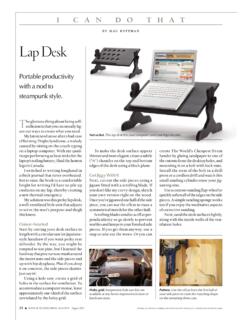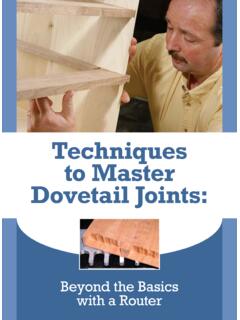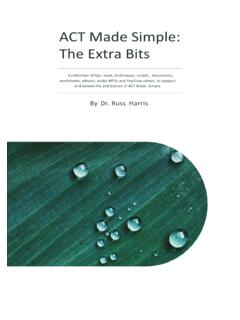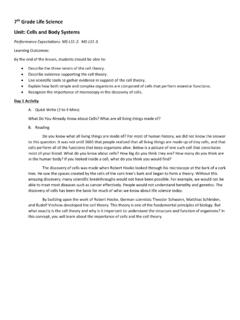Transcription of Sharpening Plane Irons & Chisels - Popular Woodworking
1 Sharpening Plane Irons & ChiselsI ve tried just about every Sharpening system there is from sandpaper to ceramics to waterstones. Here s how to get the best possible edge with the least Sharpening : fundamentalsPHOTO BY AL PARRISH1-SharpeningPlaneIrons& 941-SharpeningPlaneIrons& 946/10/09 4:07:37 PM6/10/09 4:07:37 PMWhen I took my fi rst class in woodwork-ing some years ago, the fi rst thing the instructor showed us was his shop-made waterstone a reverence and care usually reserved for religious artifacts and small injured animals, the teacher brought the pond out from its special place in his cabinet. For more than an hour he talked with a furrowed brow about secondary bevels, wire edges and polishing the backs of our edge of us in the class did our best to stifl e our yawns.
2 I kept looking at the rows of Chisels and backsaws and wondered when we were going to get to the important a week we all realized that we should have paid more attention to the Sharpening lecture. Soon there were only two sharp Chisels in the shop for a class of 10 students, and we quarreled over them. Trimming tenons with the equivalent of a but-ter knife was no I made it a point to learn to sharpen well. And I ve been fortunate to be able to use a variety of methods, including: oilstones, diamond stones, waterstones, ceramic stones, sandpaper, electric grinders and the Tormek system has its good and bad points. Some are simple, others don t make a mess, some are less expensive and most systems can put an astound-ingly good edge on tool me, the two most important qualities a Sharpening system needs are that it must be fast and it must produce the keenest edge.
3 I ll pay a little more and suffer a little mess to get a good edge in a hurry and get back to the s because I m more interested in wood-working than I am in the act of Sharpening . I have no desire to look at my edges under a microscope or fret about tiny imperfections in the metal. I m not the kind of guy who wants to meditate on my power animal as I proceed up to #500,000 grit. I want to be done and get back to the good BREEDS A KEEN EDGEThe steps I m about to describe will work with every Sharpening and honing system I know of on the market. That s because no matter what system you use, Sharpening is about one thing: Grinding and polishing the two intersecting planes of a cut-ting edge to as fi ne a point as tools you use to get there are up to you.
4 But here are a few words of advice: Pick a Sharpening system and stick with it for a good long time before giving it up. Many woodworkers who I ve talked to jump around from system to system, trying to fi nd the best thing (and spending a lot of money).If you stick with one system, your edges will improve gradually as you get better and better at using your particular set of stones or sandpaper. Skipping around from one system to the next will only stunt your Sharpening , please buy a honing guide to try. It s a big old lie that these things slow you down. In fact, these simple and inexpensive guides are quick to set up and ensure your edge will be perfect every time you , don t buy a whole rolling army of honing guides.
5 I use a $14 Eclipse-style guide (the gray-colored side-clamp contraption shown in most of the photos) for Sharpening my Chisels and most Plane Irons . I also own a Veritas Mark II honing guide. It excels at Sharpening skew Chisels and spe-cialty Plane Irons that won t fi t in the Eclipse guide, such as Irons for shoulder honing guide holds the blade a little dif-ferently, and few of them are ever perfectly square. That s OK because what you re after with a honing guide is repeatability. Use the same guide over and over, and your edges will come out the same. Sharpening Plane Irons & Chisels 95 ILLUSTRATIONS BY JOHN HUTCHINSONIF YOU DON T POLISH THE backside of your newly acquired Chisels and Plane Irons , your cutting edges will always be jagged and eas-ily dulled.
6 You need to polish just the area up by the cutting edge. This is a process you ll only have to do 951-SharpeningPlaneIrons& 956/10/09 4:07:37 PM6/10/09 4:07:37 PMGrinding the EdgePOLISH YOUR BACKSIDET here are three Sharpening operations that must be performed on all Chisels and Plane Irons that are new to you. First you must polish the fl at backside (sometimes called the cutting face ) of the tool. Next you grind the cutting bevel. Finally you hone and polish a small part of that cutting bevel, which most people call the secondary bevel. Keep in mind that these three steps are only for tools that you have newly acquired. Once you do these three things, maintaining an edge is much eas-ier.
7 You ll probably only have to polish the backside once. You ll have to regrind an edge mostly when you hit a nail or your secondary bevel becomes too large. Most Sharpening is just honing and polishing the secondary bevel so you can get back to with the backside of the tool. This is the side of the tool that doesn t have a bevel ground into it. It s one-half of your cutting edge so you need to get it Sharpening by rubbing the backside back and forth across a medium-grit Sharpening stone or sandpaper. You don t need to polish the entire back, just the area up by the cutting edge. I begin this pro-cess with a #1,000-grit waterstone, then do the same operation with the #4,000-grit and then the #8,000-grit stone.
8 The backside should look like a mirror when you re fi HONING NARROW TOOLS, THIS is the best way I ve found to keep things steady and square. Put one fi nger on the cutting edge; put the other behind the jig to move BEGIN GRINDING YOUR EDGE, put the tool in your honing guide and adjust it until the cutting bevel is fl at on your stone. Eyeball it at fi rst. After a couple passes on the stone you ll know if you re off or YOUR CUTTING BEVEL SHOULD not take long on a coarse diamond stone. If you re having trouble gauging your progress, color the cutting bevel with a permanent marker and you ll get a quick snapshot of where you YOU RE DONE GRINDING, THIS is what your edge should look Sharpening : fundamentalsplane ironbevel is flat against stonecoarse-grit diamond stone25 bevel typical1-SharpeningPlaneIrons& 961-SharpeningPlaneIrons& 966/17/09 1:52:13 PM6/17/09 1:52:13 PMWhy I Switched to WaterstonesThere are a lot of Sharpening systems out there.
9 And while I haven t tried every one of them, I ve tried most. After much experimentation, I settled about 12 years ago on a system that used DMT diamond stones and oilstones. My system worked pretty well, but the oilstone part was slow, and my fi nal cutting edge was always almost few years ago, I got my hands on a set of Norton s American-made waterstones and it was like a door had been opened for me. These things cut wicked fast. And the edge they produce is darn-near h e y f e e l d i f f e r e n t t h a n m a n y J a p a n e s e w a t e r s t o n e s I ve used. The best way to describe the difference is that the Norton stones give you different feedback as you sharpen.
10 The #4,000-grit Norton actually feels like it is cutting (it is). The #4,000-grit Japanese stones I ve used have a more rubbery feel to them in use in my opinion. And they didn t seem to cut as fast at that level. The #8,000-grit Norton waterstone also pro-vides great feedback to the downside to all waterstones is that they need to be fl attened regularly. For this job, I use a DMT DuoSharp stone with the coarse grit on one side and the extra -coarse on the other. I also use this same dia-mond stone for grinding the cutting edge of all my Chisels and Plane most economical way to get started with this system is to buy a Norton combination waterstone that has #1,000 grit on one side and #4,000 grit on the other.








